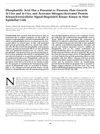signaling protein that, when suppressed, may grow hair by reducing inflammation and stem cell loss
Microscopic delivery system that sends growth-promoting signals to hair follicles
chemical that might completely regrow follicles from hair transplant extractions

